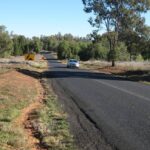Doherty Smith & Associates is now Compass Consulting Surveyors
Click here to see this blog and more on our new website compasscs.com.au
To many people, the distinction between a road reserve and the physical road is unclear. Simply put, the road reserve is that strip of land set aside for the passage of traffic along a route. The physical road formation is supposed to be contained within the legal road reserve. Where a new road is to be created, surveyors play a vital role. Often, legal road reserves have to be closed such that they are no longer public roads. Often, road opening works go hand-in-hand with road closing works. These processes are commonly dealt with by surveyors in NSW.
There are several categories of roads:
Private roads – when Old System land was subdivided, often roads were “declared” on the plan. Unfortunately, due to the fact that these plans pre-dated the Local Government Act, these roads became Private Roads and remained vested in the owner of the land prior to subdivision. Private roads commonly exist as laneways, however they are not controlled by a council or government department. Dealing with Private Roads can be difficult, as almost certainly the original land owner has passed away, which can create problems with Old System land boundary definitions.
Public Roads – These roads are “opened or dedicated for the free right of passage of the public on foot, in a vehicle, or otherwise” (NSW Registrar General’s Directions http://rgdirections.lpi.nsw.gov.au/deposited_plans/roads/general_principles ). Public roads are controlled by a local council or other authority such as NSW Roads and Maritime Services. The land making up the road reserve itself is held in the ownership of the Crown (State of NSW).
Crown Roads – A crown road is a public road under the control and care of Crown Lands and remains Crown Land. Examples of Crown Roads include portion boundary and reserved roads. See more in our blog here.
Roads are created or closed under the Roads Act 1993. The Roads Act sets out procedures for opening and closing public roads and establishes the authorities responsible for roads.
Opening a new road can only be done by an authority such as the local council or NSW RMS. There are many ways to dedicate land as public road as follows:
- Land shown on a plan of subdivision as road, with a statement of intention to dedicate the land as public road, is created as public road upon registration of the plan.
- Land currently in the ownership of a council or the RMS can be dedicated as public road by publication of a notice in the Government Gazette.
- Land acquired by the Minister administering the Crown Lands Act can be dedicated as public road by publication of a notice in the Government Gazette.
- Unoccupied Crown Land can be dedicated as public road by publication of a notice in the Government Gazette.
- Land owned by any public authority and used as a road can be dedicated as public road by publication of a notice in the Government Gazette.
- Land set aside as a road in a subdivision dated before January 1907 or in a plan registered prior to 1 January 1920 can be dedicated as a public road by the publication of a notice in the Government Gazette.
Typically, road openings tend to be undertaken as part of a plan of subdivision or by acquisition. Using a plan of subdivision is widely accepted as the simplest method to open a road, since the roads are opened upon registration of the plan. Using a plan of acquisition adds extra steps to the process as the lots for the road must be created, then acquired, then a gazettal notice published to dedicate the road.
Closing roads involves the consent of Crown Lands. Where a road is a Council public road, the authority in control of the road must make the application to close it. Where a road is a Crown Road, application to close the road may be made by any person. When closing a road, a Deposited Plan defining the parcels of road to be closed must be lodged with Land and Property Information NSW. Lots defining parcels of road to be closed can be created on plans for other purposes including subdivision or acquisition. It is worth noting that fees apply when closing roads, and that extensive delays in Crown Lands approval may occur.
Obtaining legal access over a route can be achieved by other methods including creation of a right of carriageway. These methods grant access, however any agreement is private and is between owners of land. As such, disagreements between land owners can lead to bitter arguments and even legal action. Public Roads offer a legal right of access backed by the Crown.
If you require further information on road opening or closing please don’t hesitate to contact Doherty Smith & Associates Pty Ltd.
Eric Smith
Registered Surveyor




